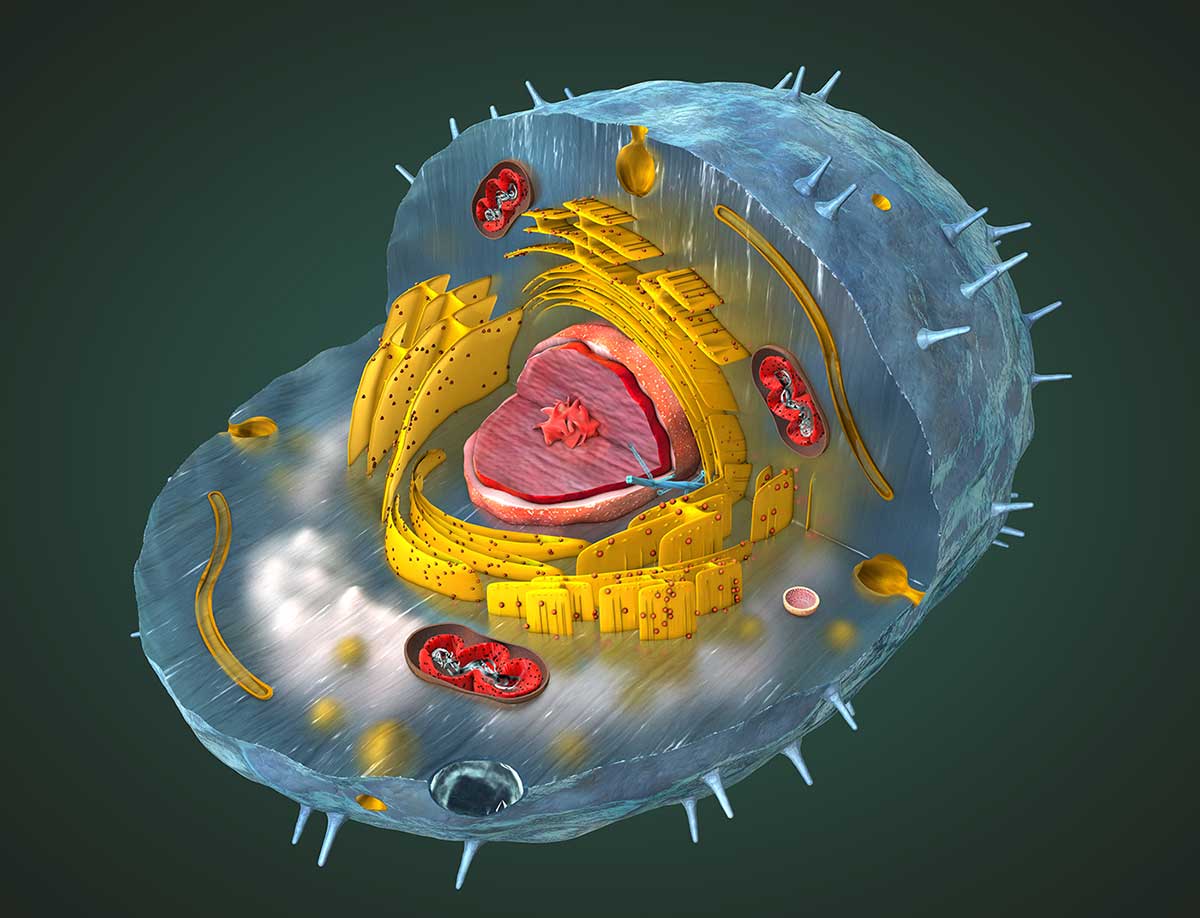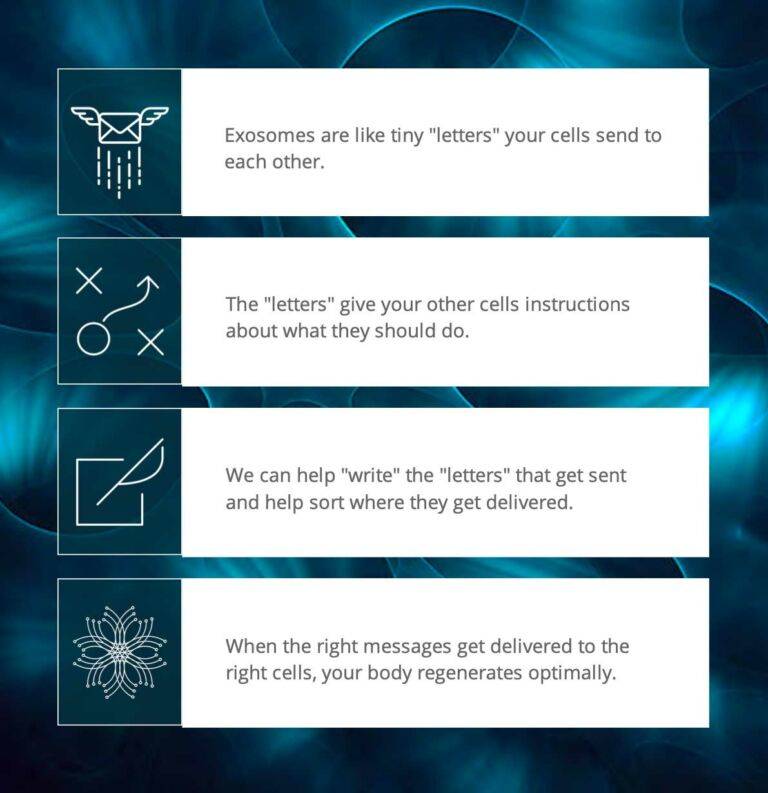Imagine the following:
- Type I diabetes cured for good
- Multiple sclerosis a thing of the past
- Maintaining beautiful, youthful skin for decades (aging slowed and even reversed)
It sounds like science fiction, but this may soon be our collective reality. It involves the advent of the most powerful anti-aging therapy to date: exosomes.
Exosomes will, quite simply, fundamentally change modern medicine. They are poised to vanquish nearly every chronic disease that plagues modern humans.

What are exosomes?
Cells in your body communicate with one another in a myriad of ways. One is called “paracrine signaling,” which is basically when one cell sends messages to neighboring cells.
Cells do this by creating a package of instructions that includes proteins, lipids, and RNA called extracellular vesicles, or exosomes. These instructions contain the blueprints for how the cell should function, what proteins to create, which cell processes to emphasize and which to slow, etc. This process happens every day, millions of times a day, all over your body.
This is nothing new or earth-shattering; scientists have known about these extracellular vesicles for years. The true revelation, however, has come in the last decade, when modern research has shown that specific types of exosomes can have extremely powerful regenerative abilities.
This includes the potential to support cells in your major organ systems, including the skin, liver, heart, nervous system, immune system, and more. These very specific exosomes may be the fountain of youth we’ve been searching for since time immemorial.
Exosomes aren’t a household name yet, but they will be.






Exosomes are like tiny "letters" your cells send to each other.



The "letters" give your other cells instructions about what they should do.



We can help "write" the "letters" that get sent and help sort where they get delivered.



When the right messages get delivered to the right cells, your body regenerates optimally.
How exosomes are different than stem cell therapy
The “fountain of youth” idea has long been linked to the science of stem cell therapy. We were convinced that stem cells would revolutionize medicine and single-handedly provide the answer to our debilitating chronic diseases. However, while much good has come from stem cell applications, we now no longer believe they are the solution to our health problems.
Why? Because when stem cells were originally being researched, scientists theorized that they would integrate with your normal tissues, grow alongside them and support them. This theory has now been largely discarded. Instead, it’s widely believed that the healing effect from stem cell treatments is largely the result of the exosomes that these stem cells secrete.
In other words, it’s not the stem cells themselves, but the exosomes that are the driving force helping to heal and normalize your own body’s cells.
Over the last ten years, volumes of research have accumulated on exosomes and their various effects. This mountain of data is, in our humble opinion, only the barest glimpse into the potential of exosomes to treat and cure disease.
These incredible results point to a shift in the direction of modern science away from giving you a substance to suppress symptoms or take away your pain, but rather assisting your body to heal itself.
After all, who knows how best to heal if not your own body?



Why are exosomes so powerful
Your cells naturally produce exosomes (also called extracellular vesicles). However, as you age, the number and types of exosomes you secrete slow down and shift, and are no longer as supportive as those produced by your younger cells. Fortunately, when exposed to the right kind of exosome treatments, your cells wake back up and start behaving like younger cells again.
There’s an incredible volume of information and research on exosomes, despite it not yet being a well-known treatment. Much of this research has been done in animal studies, so we do need to take it with a grain of salt. This is, however, the same method of study that is used to determine benefit and risk in drug development, so we should also take it seriously.
What can exosomes help with?
The real question should be, “What can’t exosomes help with?”
There are several impressive trends in the published literature. I’ll highlight five of them here:
1. Anti-aging
Research suggests that exosomes have a powerful anti-aging effect, and have been shown to rejuvenate aging cells to an impressive extent.
This is a big deal because it means you’ll be able to receive targeted treatments like “exosome facials,” which show huge promise in terms of slowing or even reversing aging in the skin.
In other words, exosome facials have the potential to stimulate glowing, radiant, healthy skin in recipients — for years.
Joe Rogan and Ben Greenfield Discuss Exosomes Facials
See how exosomes helped a 49 year old lift 900 lbs
2. Joint treatments
In terms of bone and joint health, there have been some very encouraging studies involving exosomes. If you’re recovering from surgery on your elbow or knee, for example, exosomes may be able to help — dramatically.
In bone health, exosomes have been shown to increase bone cell growth and repair of fractures. Exosome treatments have also been shown to increase growth and repair of cartilage. With age-related osteoarthritis, joints tend to lose their internal cushioning. Exosomes can also protect bone and cartilage from osteoarthritic degradation.
Exosomes have also been shown to be protective against some of the negative effects on bone from steroid use. Exosome treatments preserve lifespan of bone growth cells. And exosome-treated bone cells exhibit greater resilience and repair after being subjected to radiation during cancer treatment.
3. Overall brain health
Your cells naturally produce exosomes (also called extracellular vesicles). However, as you age, the number and types of exosomes you secrete slow down and shift, and are no longer as supportive as those produced by your younger cells.
Fortunately, when exposed to the right kind of exosome treatments, your cells wake back up and start behaving like younger cells again.
There’s an incredible volume of information and research on exosomes, despite it not yet being a well-known treatment. Much of this research has been done in animal studies, so we do need to take it with a grain of salt. This is, however, the same method of study that is used to determine benefit and risk in drug development, so we should also take it seriously.
4. Heart disease and diabetes
Heart disease alone kills one out of every 4 people in the US and is the leading cause of death for both men and women.
In many studies, exosomes have been shown to stimulate new blood vessel growth, which would be a boon for those with conditions that involve compromised blood vessels, such as heart disease, post-heart attack recovery, hypertension, type II diabetes, post-stroke recovery, etc.
Exosomes have also been shown in animal models to decrease insulin resistance in Type II diabetes and protect beta islet cells of the pancreas from destruction. Type II diabetes affects 1 out of every 10 Americans, or roughly 30 million people in the US.
Heart disease and diabetes are public health epidemics for which there has been little help from conventional medicine. Exosomes may offer a glimmer of hope for those affected individuals.
5. And so much more
It’s hard to overstate the potential for exosomes to treat chronic diseases and other conditions that cause substantial suffering in people around the globe.
One arena in which exosome treatment really shines in the research is in auto-immunity. Numerous studies point to exosome therapy helping with debilitating auto-immune conditions including Lupus, multiple sclerosis, inflammatory bowel diseases, uveitis, synovitis, etc. In experimental models of colitis, exosomes have been shown to greatly reduce inflammation and increase antioxidant protection.
Nerve injuries have also been treated successfully with exosomes, which have been shown to promote peripheral nerve regeneration and may be a future treatment for nerve injury. Exosome infusions have been shown to dramatically decrease pain related to peripheral nerve injury. Taste bud regeneration has been observed with exosome treatments following conventional treatment for tongue cancer. Other noted benefits of exosomes in the literature include helping to reverse kidney disease as well as having an antiviral effect against the Hepatitis C virus.



A full 4 out of the 10 leading causes of morbidity and mortality worldwide are lung diseases, and exosome research on the lungs is very encouraging. Exosomes can repair acute lung injury and normalize function. This would be useful for lung conditions like COPD, asthma, ARDS, inflammatory lung diseases[38], and healing from lung cancer.
Exosomes have also shown promise in treating nerve damage and resulting erectile dysfunction following prostate surgery.
Finally, there are a number of human trials underway to evaluate the efficacy of exosome treatment for various difficult conditions like trigeminal neuralgia and treatment-resistant depression. Time will tell if these conditions also benefit from this therapy, as well.
Who can get exosome therapy?
While most people are likely good candidates, it’s important to be properly evaluated by a medical profession before receiving exosome treatments.
This is because a few different populations may not be good candidates for receiving exosomes. For example, cancer cells produce their own exosomes, which is one way cancer grows and spreads.
If you currently have cancer, had it in the past, or have a strong family history of it, exosome therapy could theoretically put you at greater risk. I’m not aware of any cases in which the administration of exosomes led directly to an increase in cancer growth or invasiveness, but my professional opinion is that until we learn more, it’s simply not worth the risk.
Likewise, if you currently have a viral infection, known high viral load, or are prone to viral reoccurrence like in shingles, exosome therapy may not be for you. Since exosomes are so adept at tamping down the immune system, viral infections can potentially flourish if present. While there is research on exosomes having an anti-viral effect on the Hepatitis C virus, if there’s an active viral infection or known high viral load, exosome treatments may not be prudent.



What’s it like getting an exosome treatment?
The actual process of receiving exosomes is relatively simple. They can be administered in a number of different ways, from topically as a facial treatment, injection into a joint, or given as an intravenous infusion.
The treatment itself is relatively painless (you must consent to being stuck with a needle) and there generally is no downtime after receiving exosomes. The whole process takes under an hour.
In terms of when to repeat the treatment, it depends on your specific health goals and your assessment by your medical health professional.
How long does it take to see results?
This varies depending on the specific health concern you’re looking to address, and what your relative health is before receiving the treatment. In other words, there’s no easy answer.
It’s also important to mention that you should only receive exosome treatments from qualified and trusted medical professionals. Exosomes are only able to be purchased and administered by qualified medical professionals, but not all exosomes are created equal. I recommend solely seeking exosomes produced from amniotic or placenta-derived mesenchymal stem cells that have been screened, from donor tissue found to be free of communicable diseases including HIV, Hepatitis B, Hepatitis C, Syphilis, Cytomegalovirus, HTLV, Zika, EBV, Hepatitis E, HBV, HHV6, HHV7, HHV8, HSV1 & 2, HTLV1, HTLV2, BKV, and Norovirus.



The future
Exosomes are one of the most exciting scientific breakthroughs I’ve ever seen in my career. That may sound like hyperbole, but it’s true.
We function at our peak when we feel good, look good, and can contribute to the best of our abilities. I’m pleased to administer exosome treatments and contribute to even more health, vitality, and inspired joy in the world.
Neuroscience 320: 129-139 2 BMC Biology volume 14, Article number: 46 (2016)
Front Immunol 5: 556; Rom J Morphol Embryol. 2018;59(3):655-662; Stem Cells Int. 2016; 2016: 5802529
Stem Cells 36(3): 420-433; Stem Cell Research & Therapy volume 10, Article number: 142 (2019)
Stem Cells 36(3): 420-433
FEBS Lett 590(1): 185-192; Stem Cells Transl Med 5(12): 1620-1630
Stem Cells Transl Med 5(12): 1620-1630.; Int J Biol Sci 12(7): 836-849; Oncoscience 5(5-6): 181-195; ACS Appl Mater Interfaces 10(6): 5240-5254
Osteoarthritis Cartilage 24(12): 2135-2140; Semin Cell Dev Biol 67: 56-64; Stem Cell Res Ther 8(1): 189
Sci Rep 7(1): 16214; In Vitro Cell Dev Biol Anim
Int J Biol Sci 12(10):1262-1272
Oxid Med Cell Longev 2017: 7197598 [
Stem Cell Res Ther 10(1): 30
Cell Mol. Bioeng. 9, 509–529 (2016)
Mol Neurobiol 54(4): 2659-2673
Neuroscience 320: 129-139
Front Neurosci 12: 845; J Neurotrauma. 2019 Feb 1;36(3):469-484
Mater Sci Eng C Mater Biol Appl 89: 194-204; Nano Lett 18(8): 4965-4975 [17] Zhongguo Yi Xue Ke Xue Yuan Xue Bao 38(1): 33-36
Curr Gene Ther 18(5): 307-323
Sci Rep 6: 24805
J Neurotrauma 34(24): 3388-3396
J Cardiovasc Transl Res 11(5): 429-437
Biomed Pharmacother 105: 1240-1247
J Mol Neurosci 65(1): 74-83
ACS Nano 12(8): 7613-7628
Int J Mol Sci 18(4)
Front Vet Sci 4: 39
Cell Transplant 24(2): 133-149
PLoS One 10(10): e0140551
Neurorehabil Neural Repair 32(9): 765-776
Pain. 2019 Jan;160(1):210-223
J Dent Res: 22034518804531
Stem Cell Res Ther 4(2): 39;
Stem Cell Res Ther 4(2): 34.; Am J Physiol Renal Physiol 306(11): F1251-1259; 67 Eur J Pharmacol 790: 83-91
Stem Cells Transl Med 5(9):1190-1203
Stem Cells 32(1): 116-125
1] Exp Cell Res 363(1): 114-120
Stem Cells Transl Med 4(10): 1199-1213; Horie, S. and J. G. Laffey (2016) [1] J Clin Med 7(10)
Trends Mol Med 21(9): 533-542
Andrology 6(6): 927-935

Very good write-up. I definitely appreciate this site. Stick with it!
What a fascinating read! I’ll definitely be returning to this site for more content like this.